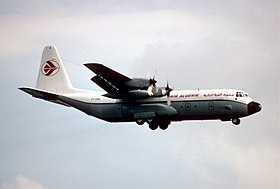Air Algérie flight 2208
| Air Algérie flight 2208 | |
|---|---|
|
The affected machine |
|
| Accident summary | |
| Accident type | Loss of control after failure of the autopilot |
| place | near Piacenza , Italy |
| date | August 13, 2006 |
| Fatalities | 3 |
| Survivors | 0 |
| Injured | 0 |
| Aircraft | |
| Aircraft type |
|
| operator |
|
| Mark |
|
| Departure airport |
Algiers Airport , Algeria |
| Destination airport |
Frankfurt Airport , Germany |
| Passengers | 0 |
| crew | 3 |
| Lists of aviation accidents | |
The Air Algérie flight 2208 (flight number IATA : DH2208 , ICAO : DAH2208 , call sign: AIR ALGERIE 2208 ) is an intercontinental scheduled cargo flight of Air Algérie from Algiers to Frankfurt . On August 13, 2006 the flight was carried out with a Lockheed L-100-30 Hercules . While cruising over the airspace of Italy, the autopilot failed , whereupon the aircraft fell uncontrollably to the ground near Piacenza . All three occupants of the machine died in the accident.
plane
The aircraft was a Lockheed L-100-30 Hercules with serial number 4880 , which had made its maiden flight in 1981. It was the civilian version of the Lockheed C-130 Hercules military transport aircraft . The aircraft was delivered to Air Algérie in May 1981 with the US aircraft registration number N4148M and was re-registered to the Algerian registration number 7T-VHG the following year . The four-engine transport aircraft was equipped with four Allison 501-D22A turboprop engines.
Inmates
On the cargo flight there was only a three-person crew on board the machine, consisting of a flight captain, a first officer and a flight engineer.
the accident
The machine was cruising in Italian airspace at an altitude of approximately 24,000 feet (approximately 7,300 meters) when the flight control computer suddenly indicated a problem with the autopilot. Twelve seconds later the autopilot switched off suddenly. The controllability of the machine was instantly lost. Shortly before contact between the machine and air traffic control in Milan broke off, the crew reported from an altitude of 13,500 feet (approx. 4,100 meters) that an engine had failed. The pilot still managed to steer the machine away from densely populated areas. The machine hit the ground at the Besurica settlement in Piacenza, 73 seconds after the warning, killing all three crew members and completely destroying the machine.
Accident investigation
According to calculations, the machine hit the ground with a pitch angle of 45 to 50 degrees and a flight speed of 850 to 900 km / h. Immediately before the collision, the structural load limits of the machine were exceeded, causing the fuselage to break into two parts. The collision was so huge that the debris of the machine was scattered over a distance of several kilometers. Immediately after the impact, there was a violent explosion, the echo of which could be heard throughout the urban area of Piacenza. A crater with a length of 50 meters and a depth of 15 meters was created at the crash site. The top of the rudder was found 1,200 meters from the point of impact, while parts of the elevator flaps were found 3,000 meters from the point of impact. The accident was attributed to a loss of control due to a failure of the autopilot.
consequences
During the investigation into the accident, it was found that the flight data recorder of the machine belonged to the first generation of these devices from the 1960s. It no longer complied with the ICAO regulations . The Italian aviation safety authority then recommended that the Algerian aviation authority replace old flight data recorders with new ones.
swell
- Accident report L-100-30, 7T-VHG in the Aviation Safety Network
- Crashed Air Algerie Lockheed L-100 Hercules suffered autopilot problem , Flightglobal , October 13, 2006.
- Helen Massy-Beresford: Italian investigators find flight data recorder from August Air Algérie civilian Hercules crash , Flightglobal , October 9, 2006.
- Helen Massy-Beresford: Italian aviation safety agency urges Algerian authorities to enforce rules on modern flight data recorders in light of August 2006 Air Algérie crash , Flightglobal , February 2, 2007.
- Operational history of the machine on planelogger.com
